The war plant worker shown here is conducting perfomance tests on a piece of military equipment. She is in a copper-screened booth at RCA laboratory. The picture appeared 75 years ago this month, November 1944, on the cover of Radio News.

The war plant worker shown here is conducting perfomance tests on a piece of military equipment. She is in a copper-screened booth at RCA laboratory. The picture appeared 75 years ago this month, November 1944, on the cover of Radio News.
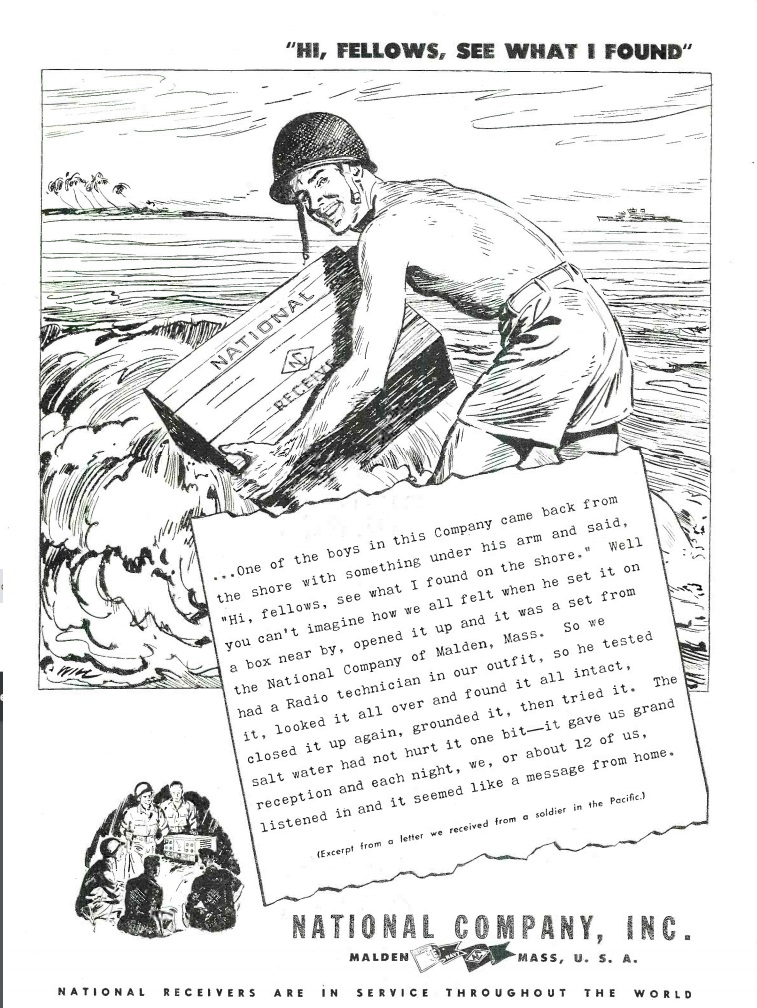 This compelling testimonial appeared in Radio News 75 years ago this month. Somewhere in the Pacific, a soldier found a crate washed up on shore, with a National receiver inside. He and his buddies checked it out, cleaned it up, grounded it (probably a good idea), and fired it up. Despite its time spent in the brine, it functioned flawlessly.
This compelling testimonial appeared in Radio News 75 years ago this month. Somewhere in the Pacific, a soldier found a crate washed up on shore, with a National receiver inside. He and his buddies checked it out, cleaned it up, grounded it (probably a good idea), and fired it up. Despite its time spent in the brine, it functioned flawlessly.
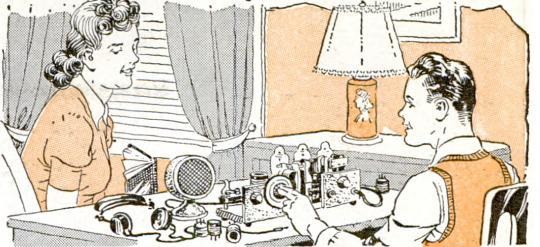 The young man shown here is pulling in the short waves thanks to a simple receiver designed around wartime parts shortages. The set used three tubes, which could be types 30, 199, or 201-A, obsolete tubes used by older battery sets. It featured two stages of audio amplification, and could drive either headphones or a small speaker. It pulled in shortwave signals from 160 to 10 meters with homemade plug-in coils. The detector was regenerative, with a variable capacitor controlling regeneration.
The young man shown here is pulling in the short waves thanks to a simple receiver designed around wartime parts shortages. The set used three tubes, which could be types 30, 199, or 201-A, obsolete tubes used by older battery sets. It featured two stages of audio amplification, and could drive either headphones or a small speaker. It pulled in shortwave signals from 160 to 10 meters with homemade plug-in coils. The detector was regenerative, with a variable capacitor controlling regeneration.
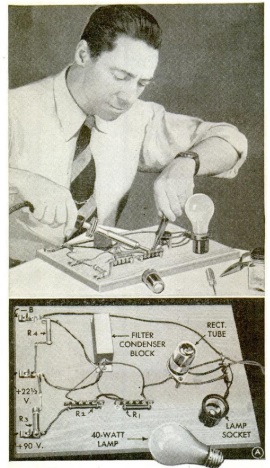 If B batteries were unavailable (a likely scenario given wartime shortages), then the transformerless battery eliminator shown here could be used. The set appeared in Popular Mechanics 75 years ago this month, November 1944.
If B batteries were unavailable (a likely scenario given wartime shortages), then the transformerless battery eliminator shown here could be used. The set appeared in Popular Mechanics 75 years ago this month, November 1944.
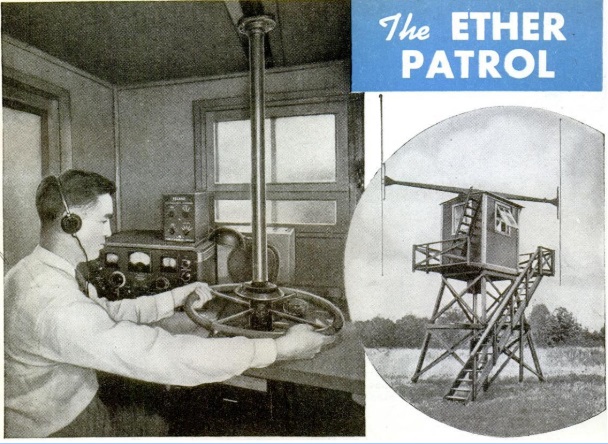 Shown above, from the November 1944 issue of Popular Mechanics, is one of the operators at an FCC Radio Intelligence Division monitoring stations. He was rotating an antenna capable of narrowing down the incoming signal to one degree, in order to track down a clandestine transmitter somewhere in the U.S., or even abroad.
Shown above, from the November 1944 issue of Popular Mechanics, is one of the operators at an FCC Radio Intelligence Division monitoring stations. He was rotating an antenna capable of narrowing down the incoming signal to one degree, in order to track down a clandestine transmitter somewhere in the U.S., or even abroad.
The majority of operators were hams, and they had the procedure down to a science. They scanned the bands looking for unfamiliar signals. As soon as an unknown station was heard at one station, other stations were immediately notified by teletype and took bearings. Those bearings were then sent to Washington for a fix. At that point, one of 50 mobile units was notified, and would sniff out the transmitter. Finally, an RID man would find the exact location on foot. And as shown below, they would then raid the offending location, presumably with FBI men accompanying with the machine guns.
Before the war, there was little need for such extensive monitoring. But from 1940 to the date of the article, over 9000 cases of unlicensed and subversive transmitters had been spotted. Over 200 spies had been rounded up in South America thanks to RID bearings.
Some transmissions were high speed code, but the stations were equipped with recording devices, and transmissions could be played back at a lower speed. The stations were also invaluable for locating downed aircraft, both military and civilian.
 Here’s another snapshot of wartime grocery prices from 1944, from the November 9, 1944, issue of the Milwaukee Journal. None, or very few, of the items shown here required ration coupons, as would be the case for sugar, meat, and some other items.
Here’s another snapshot of wartime grocery prices from 1944, from the November 9, 1944, issue of the Milwaukee Journal. None, or very few, of the items shown here required ration coupons, as would be the case for sugar, meat, and some other items.
As with pre-1964 prices, one way to convert to today’s money is to remember that one dollar meant one silver dollar, four silver quarter, or ten silver dimes, or about an ounce of silver, which would be worth about $18.
Flour was $1.17 for a 25 pound bag. A pound of coffee would set you back 21 cents, and a 12 ounce box of Grapenuts was 13 cents. And a package of “Kool-Aid Ice Cream Mix” was only a nickel.
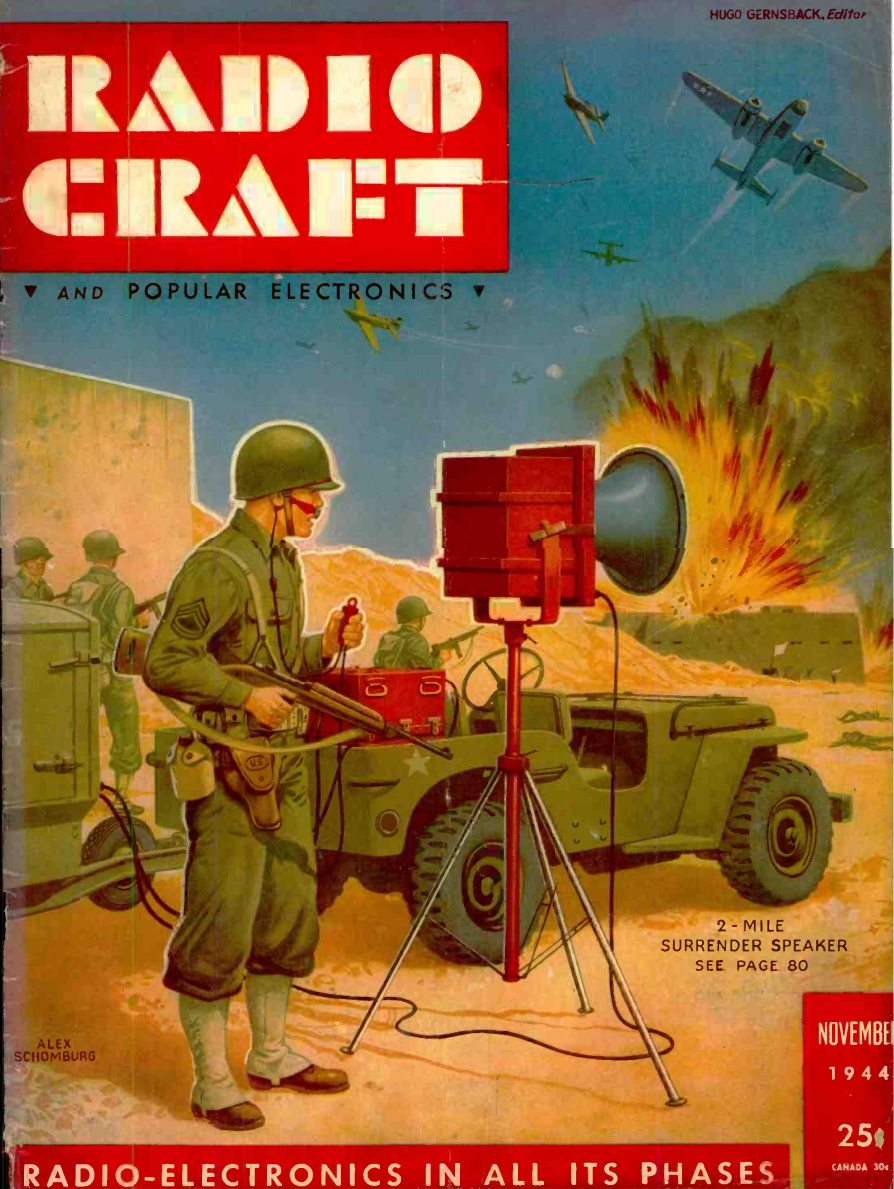 Seventy-five years ago this month, it was clear that the Allies would soon prevail against both Germany and Japan. Therefore, it was soon time to break out the surrender speakers. In fact, such speakers had already been used in all theaters of war to encourage the enemy to surrender. It was found to be particularly useful when the enemy had been encircled or contained in a small pocket.
Seventy-five years ago this month, it was clear that the Allies would soon prevail against both Germany and Japan. Therefore, it was soon time to break out the surrender speakers. In fact, such speakers had already been used in all theaters of war to encourage the enemy to surrender. It was found to be particularly useful when the enemy had been encircled or contained in a small pocket.
The model shown here was rated at 175 watts, and could peak at 350 watts, allowing it to be heard two miles away. It could be operated in relative safety, since once the speaker was in place, not only could the enemy not see it, but the microphone could be a further distance away.
The set had already been used at Cherbourg and other areas in Normandy, and resulted in the surrender of hundreds of German soldiers.
The setup is shown here on the cover of Radio Craft , November, 1944, which pointed out that the operator must be fluent in the enemy’s language. The enemy is told that the situation is hopeless and that further bloodshed is useless. This is followed by directions for surrender.
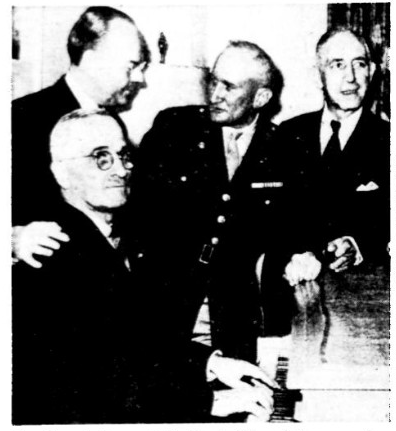 Seventy-five years ago today, November 7, 1944, Franklin Roosevelt won an unprecedented fourth term as President. Shown here is “the piano playing candidate,” the Vice-President-Elect, Missouri Senator Harry S Truman, celebrating with some buddies from his service in World War I. The picture appeared in the Milwaukee Journal, November 8, 1944.
Seventy-five years ago today, November 7, 1944, Franklin Roosevelt won an unprecedented fourth term as President. Shown here is “the piano playing candidate,” the Vice-President-Elect, Missouri Senator Harry S Truman, celebrating with some buddies from his service in World War I. The picture appeared in the Milwaukee Journal, November 8, 1944.
Just five months later, Truman would become President upon the Roosevelt’s death on April 12, 1945.
 This wistful look at the possibilities for postwar home appliances appeared in Radio Craft magazine 75 years ago this month, November 1944. The idea had been sent in to the magazine by George Predential of Schenectady, NY, and penned by cartoonist Frank Beaven. One wonders what they would think of modern bread machines, some of which are shown below.
This wistful look at the possibilities for postwar home appliances appeared in Radio Craft magazine 75 years ago this month, November 1944. The idea had been sent in to the magazine by George Predential of Schenectady, NY, and penned by cartoonist Frank Beaven. One wonders what they would think of modern bread machines, some of which are shown below.
Some links on this page are affilliate links, meaning that this site is paid a small commission if you buy after clicking on the links.
 Shown here is Sgt. Donald L. De Velder of Rochester, NY. He was stationed in Panama, and spent fruitless months trying to find a radio. After finding nothing but the opportunity to spend a fortune on an old beat up piece of tin, he decided to take matters into his own hands and build his own.
Shown here is Sgt. Donald L. De Velder of Rochester, NY. He was stationed in Panama, and spent fruitless months trying to find a radio. After finding nothing but the opportunity to spend a fortune on an old beat up piece of tin, he decided to take matters into his own hands and build his own.
Together with Staff Sergeant Emmet Ellis of Nigara Falls, NY, he was able to assemble this two-tube set. It ran off the 110 volt line cord, and a short antenna running down his foot locker allowed him to pull in the local Armed Forces station, as well as other Panamanian stations. The cabinet was made of plywood, and almost all parts were scrounged up from junk heaps. The only expense was for the 32L7 tube, which set the Sergeant back $2, although he was quick to point out that he could have found it for 69 cents back in the States.
The set used two dual tubes. A 12B8 served as RF amplifier and detector. The 32L7 provided audio amplification to drive a PM speaker, with the other half of that tube serving as rectifier. The set was written up in the November 1944 issue of Popular Mechanics. Sgt DeVelder died in 2007 at the age of 83.
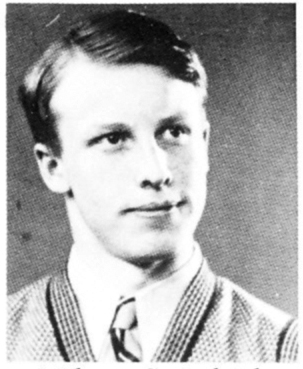
Andreas Bertnes. From the book Vestfold i Krig by Egil Christophersen, courtesy of http://www.slektsdata.no.
Today marks the 100th birthday of Andreas Olaf Bertnes, LA6R, of Sandefjord, Norway. We previously reported the 75th anniversary of his death in 1941. He was arrested in Norway by the occupying Germans for illegally using a radio transmitter.
The QST item we originally reported noted that he was 25 years old at the time of his death and a medical student. Based upon that information, we assumed that he was born in about 1916. It appears, however, that he was younger than reported at the time of his execution. According to the Norwegian government’s publication “Våre falne 1939-1945” (Our Fallen 1939-1945), he was born a hundred years ago today, 21 October 1919. He was the son of Dr. Olaf Bernes, born 1873, and Dorothea Saxlund, born 1885.
Andreas gave his life for his country on 4 December 1941. He was one of four amateur radio operators executed during the war for their resistance activities. He had been active on the air before the war. He was listed in the “calls heard” listings by an English SWL on 20 meters in November 1937 and and April 1938.
Reference